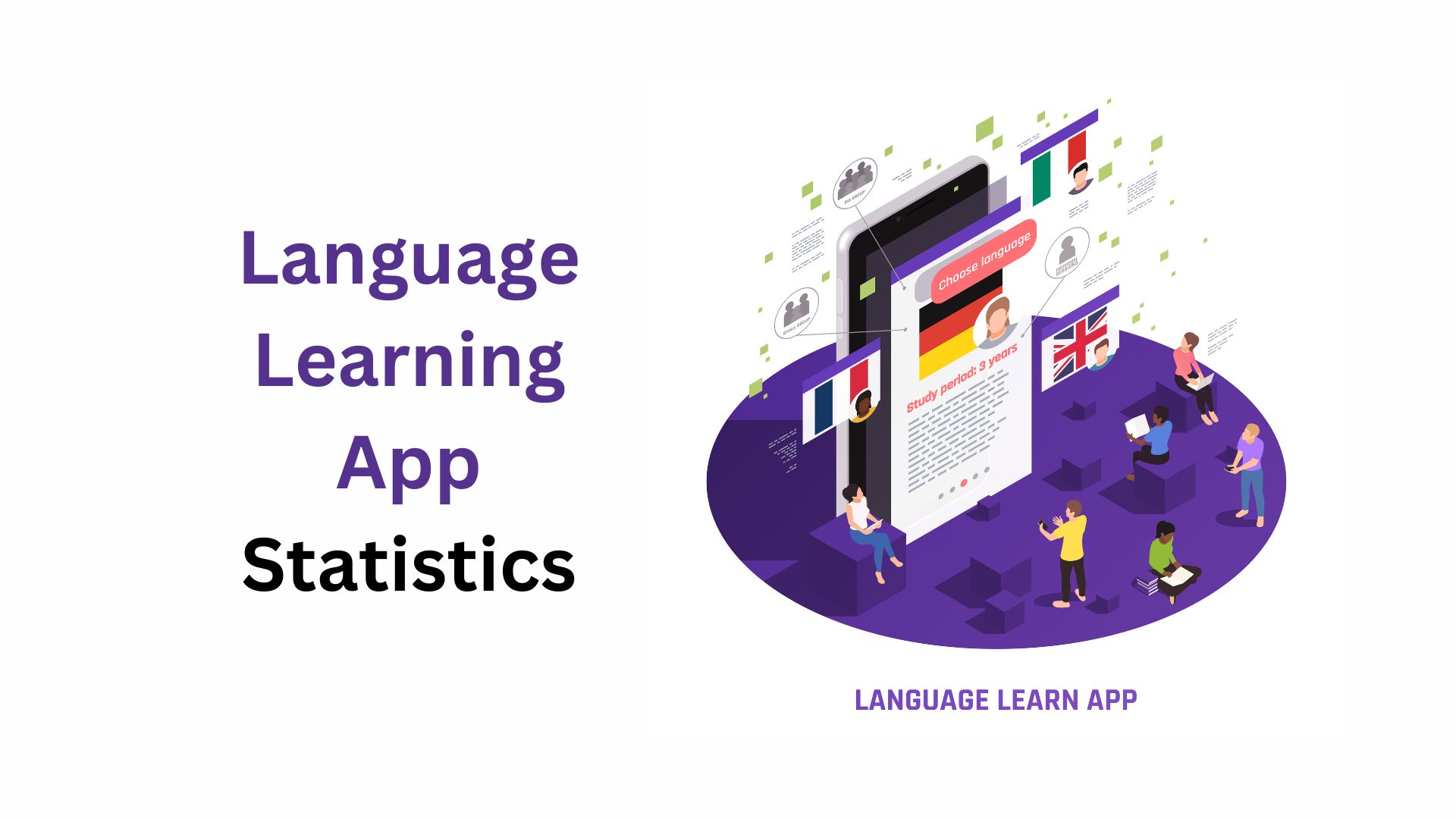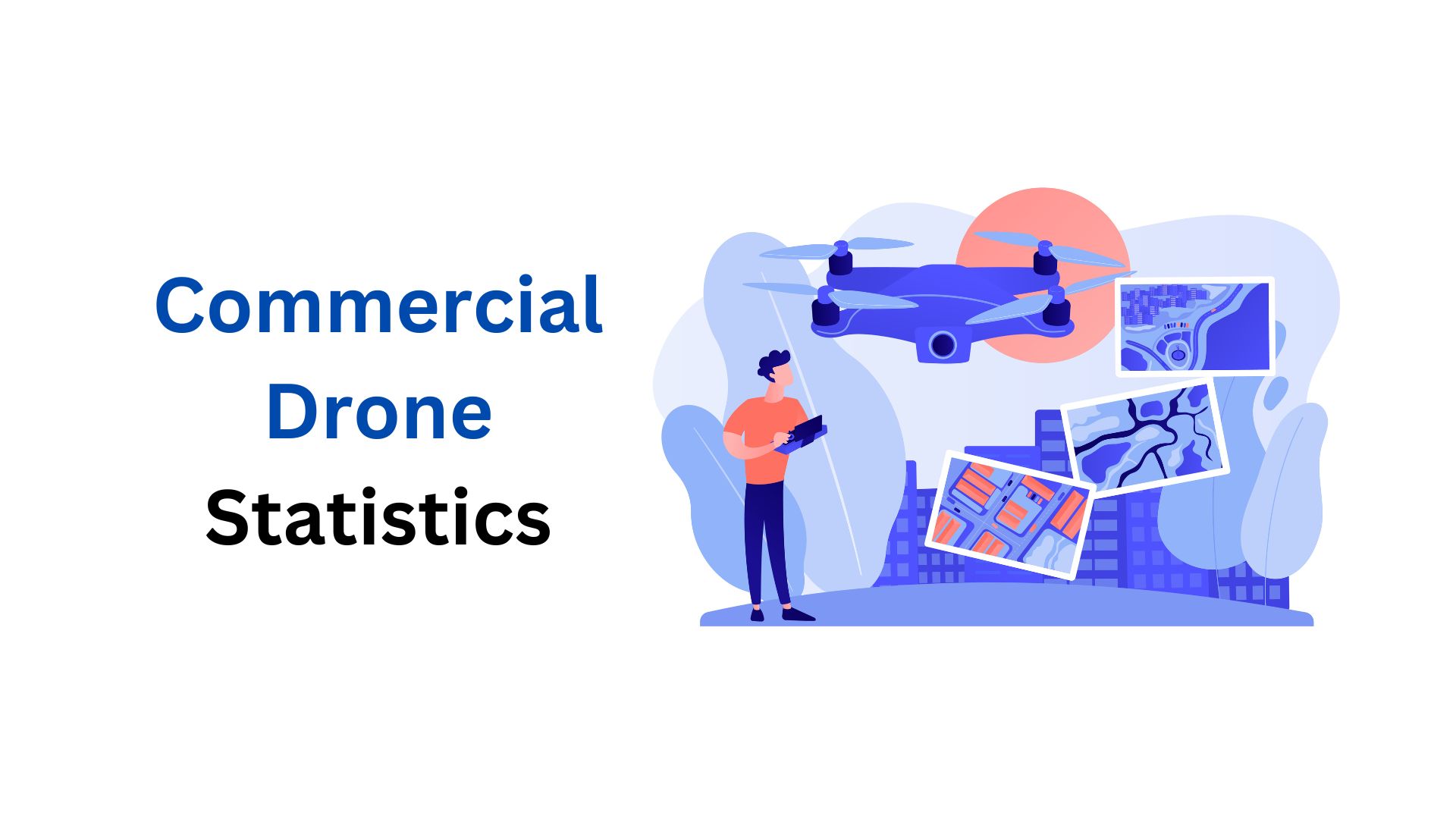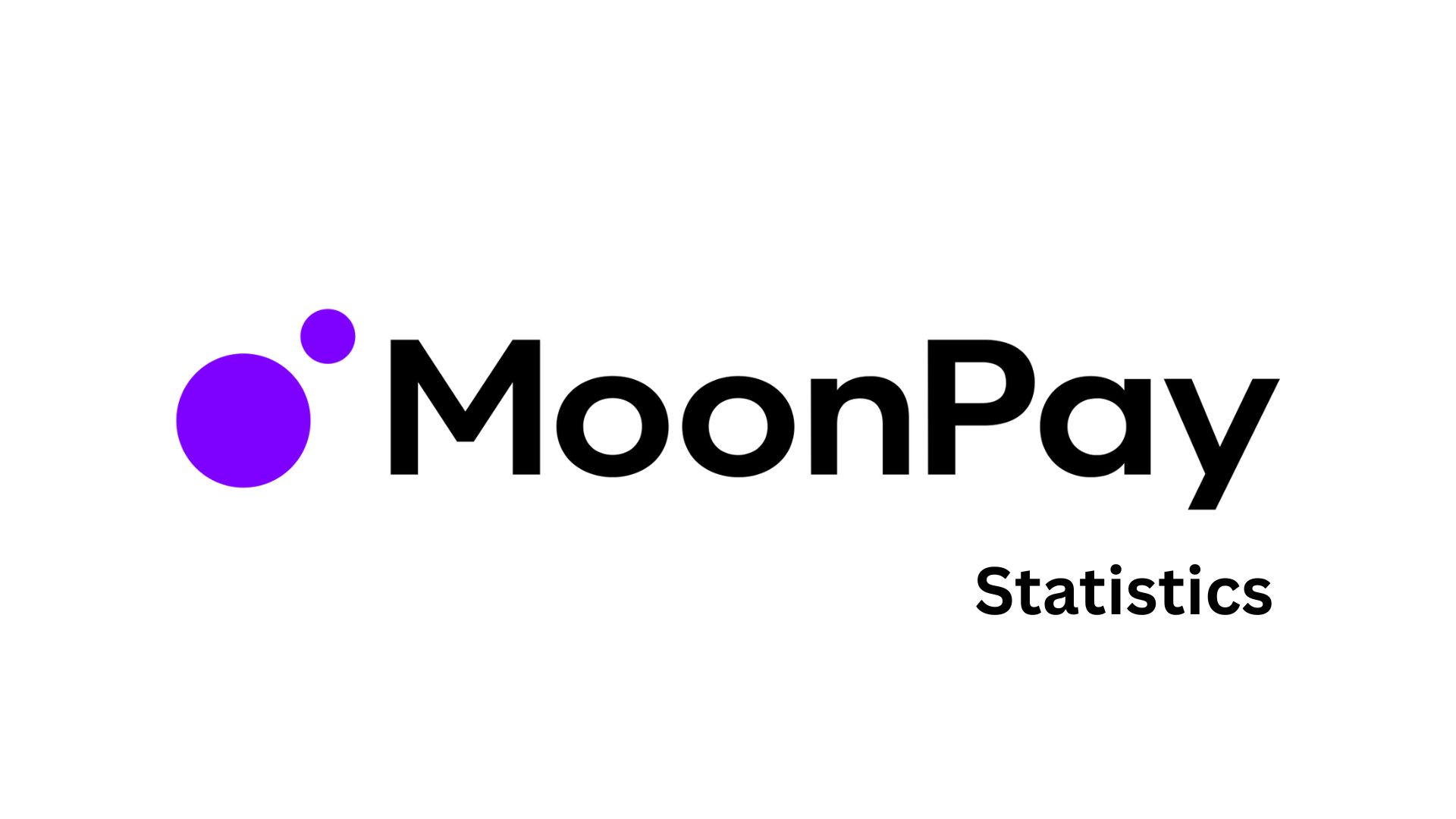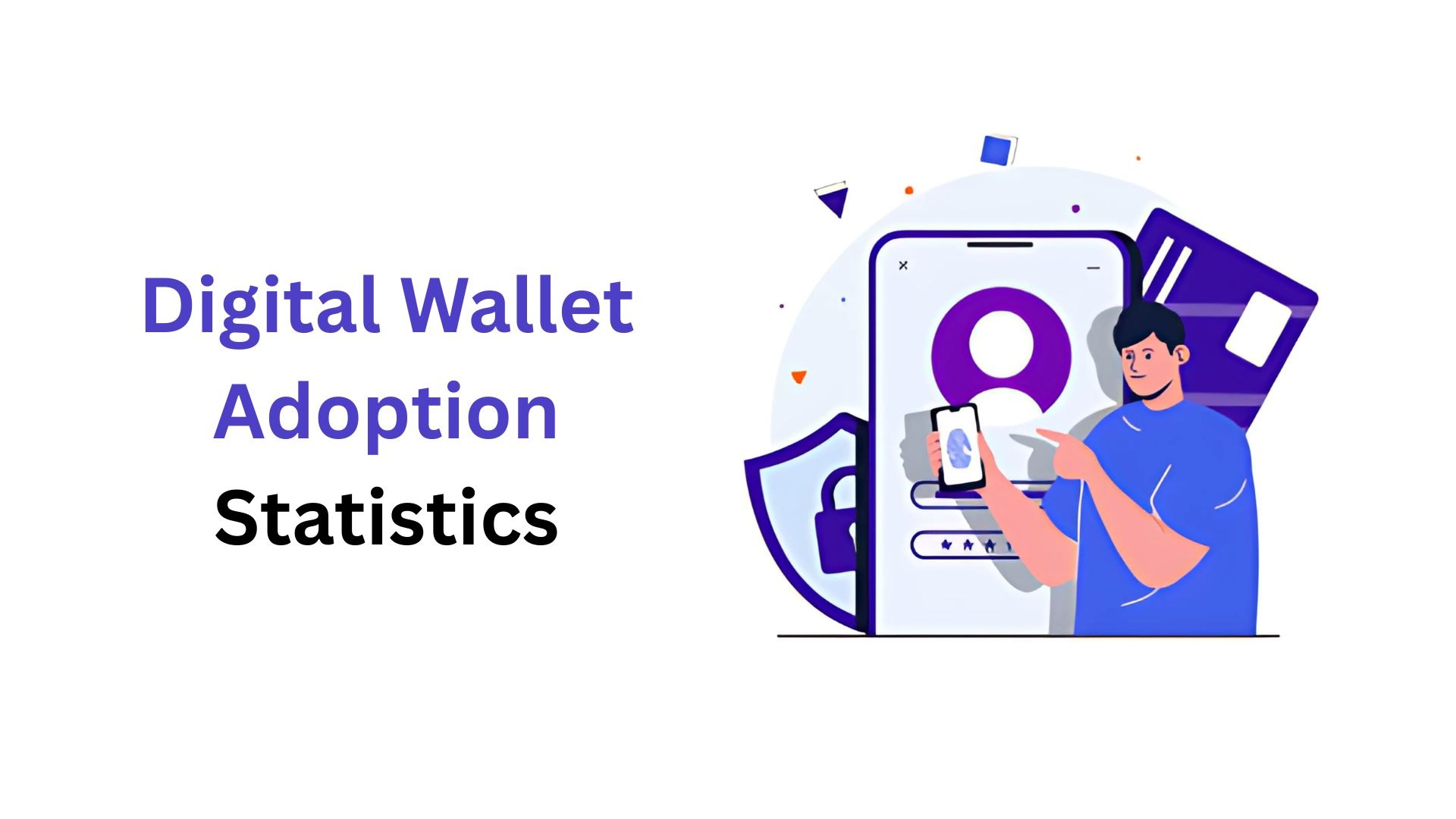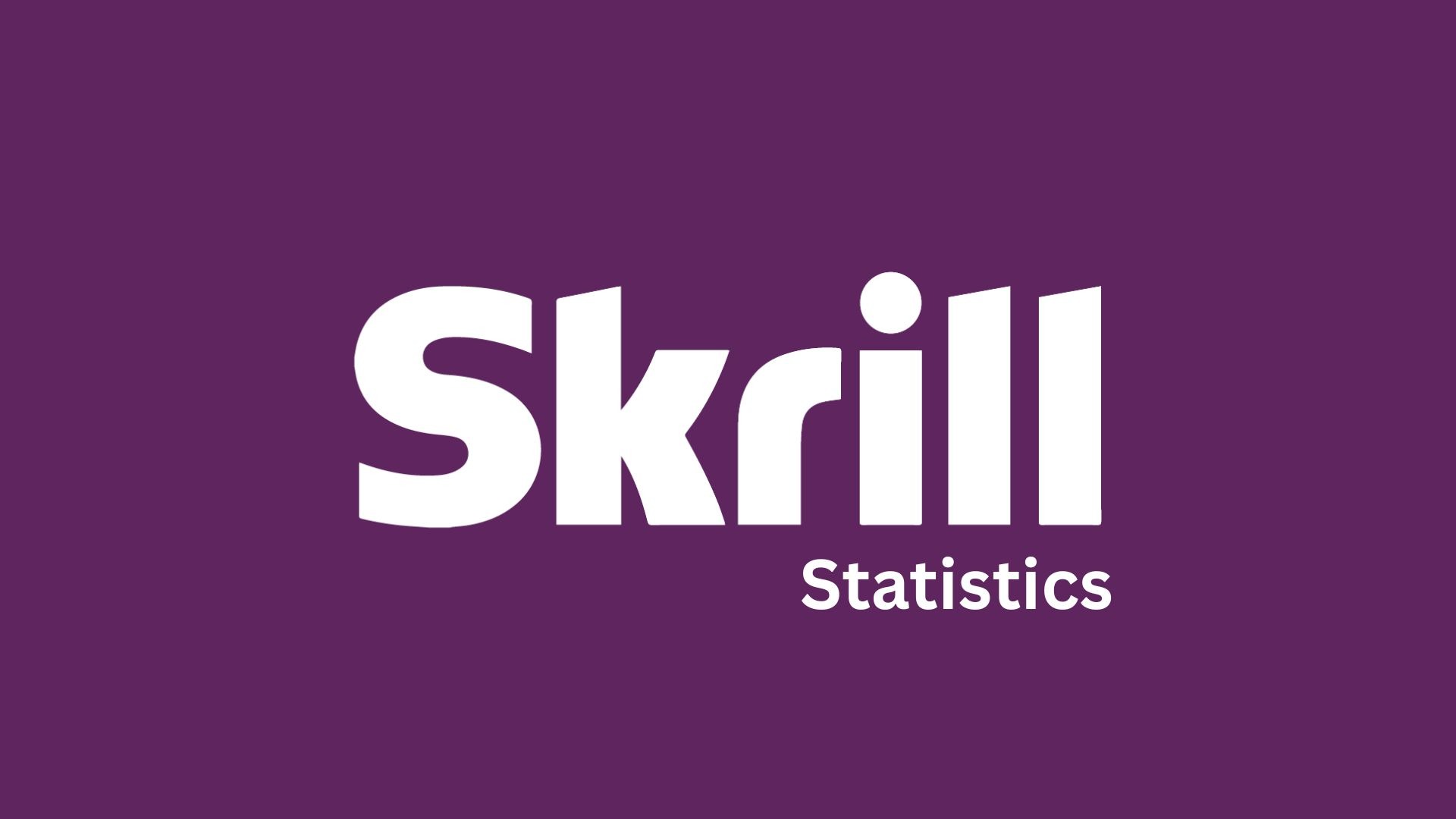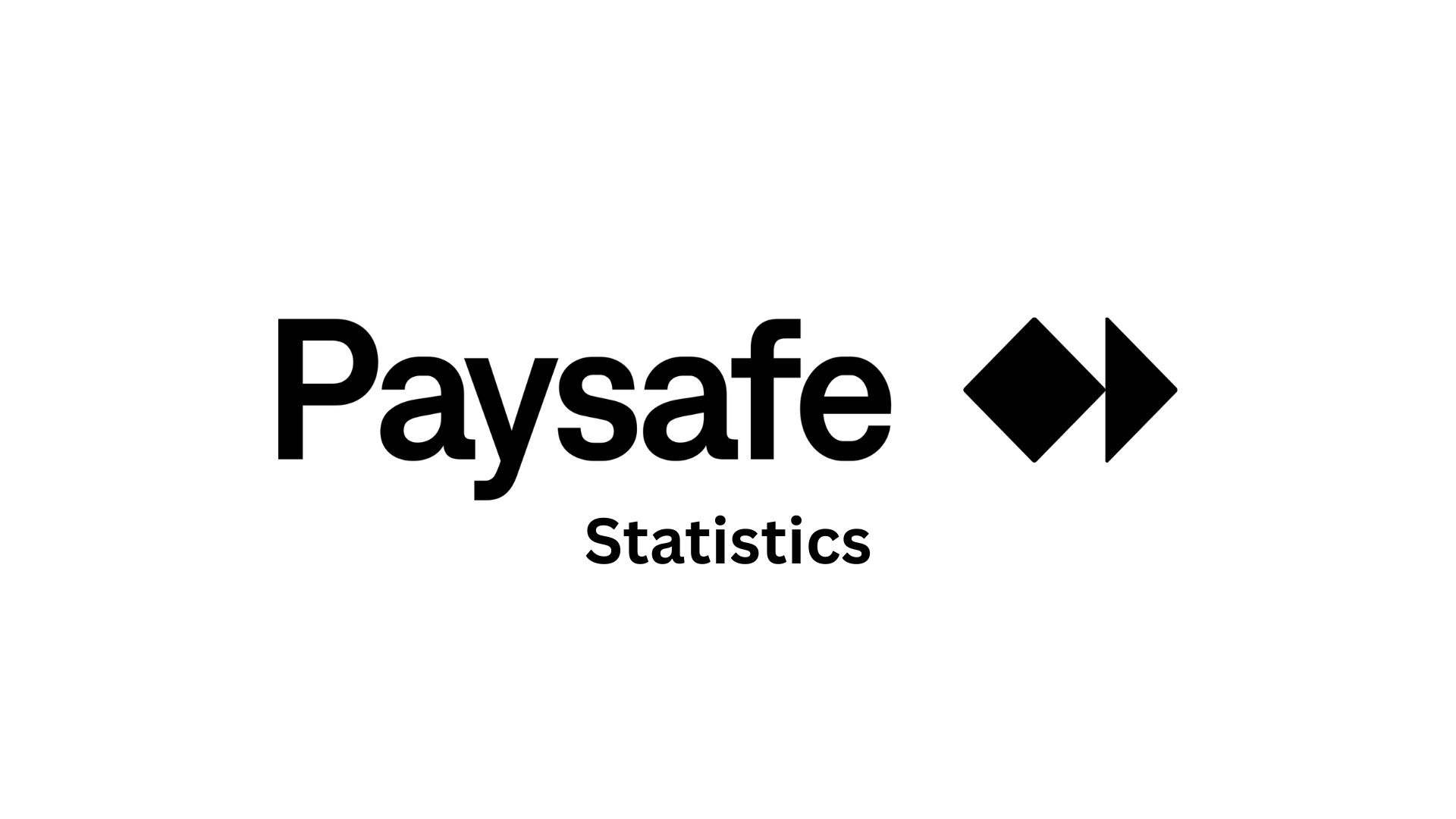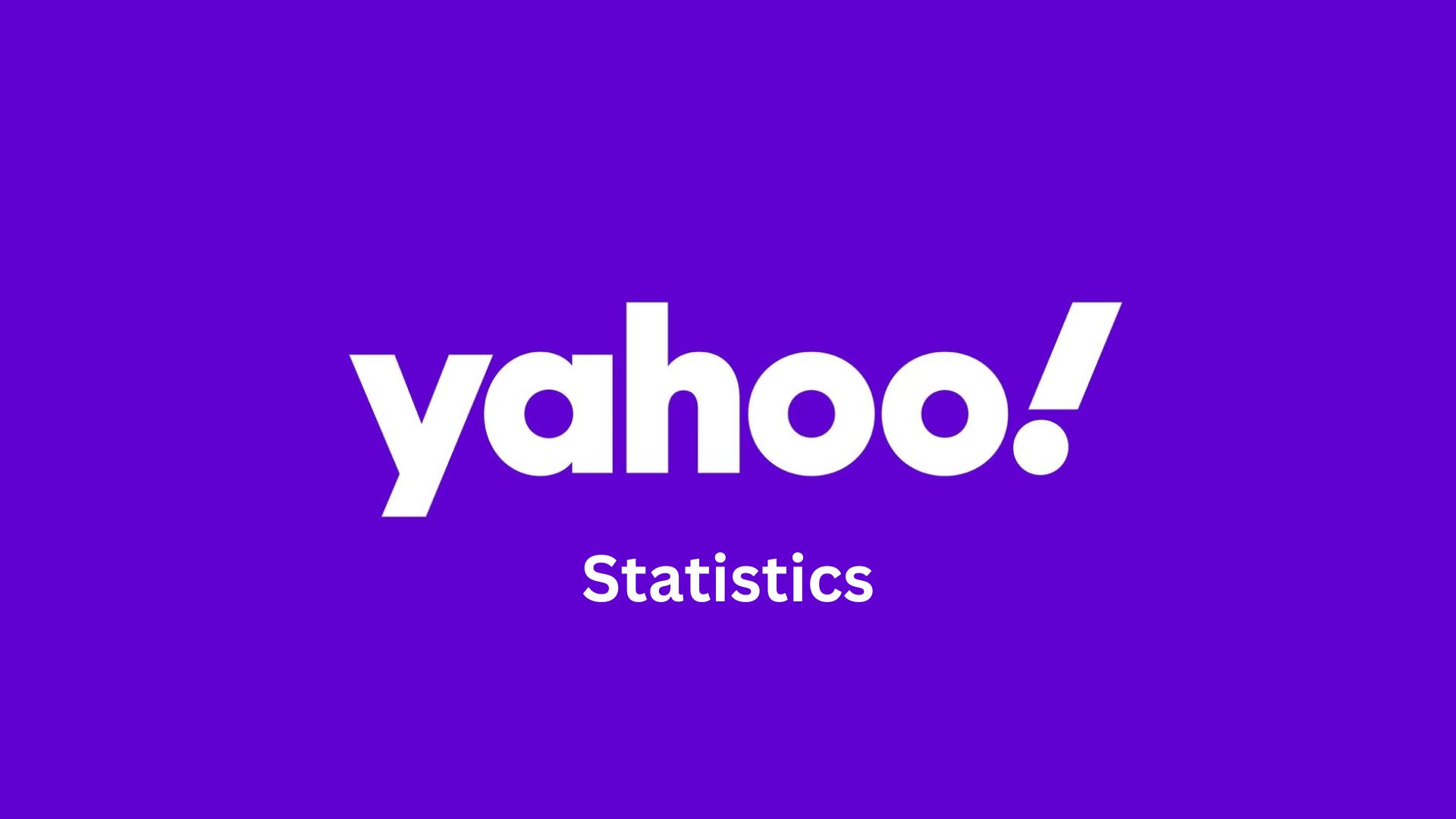AI In Cybersecurity Statistics By Market Size, Usage and Facts (2025)
Updated · Oct 24, 2025
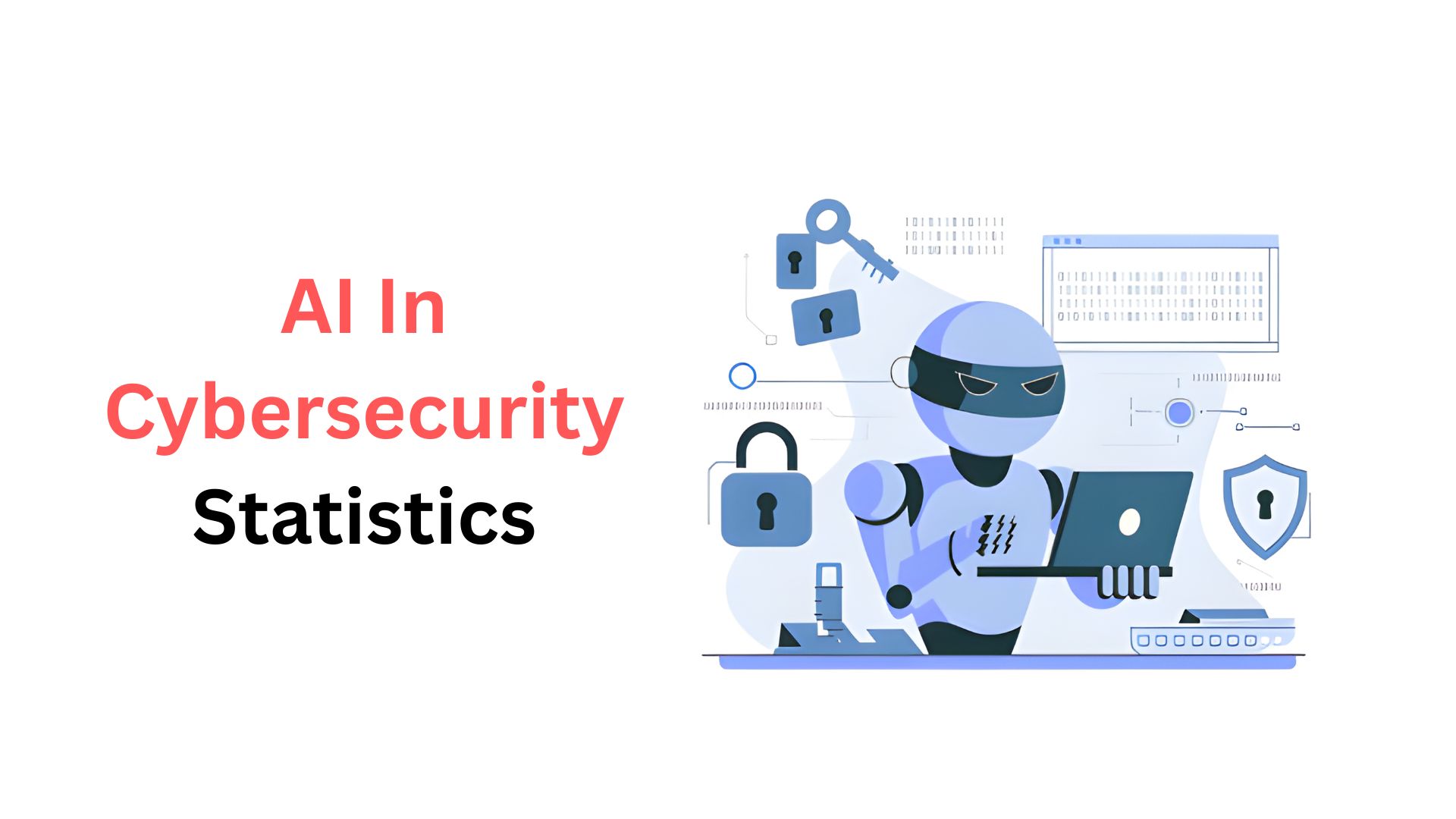
Table of Contents
- Introduction
- Editor’s Choice
- General AI In Cybersecurity Statistics
- AI In Cybersecurity Market Size
- AI In Cybersecurity By Regional
- Cost And Frequency of AI Cybersecurity
- AI-Driven Cybersecurity Prevention Aids
- AI Phishing Statistics
- AI Deepfakes Statistics
- AI Ransomware Statistics
- AI Cryptocrimes Statistics
- Key Players
- Top Platforms Driving AI In Cybersecurity
- Planned Investments in AI-driven Cybersecurity
- Technology Adoption
- AI Role In Enhancing Cybersecurity Efficiency
- Cybersecurity With AI-Driven Threat Detection And Response
- Challenges of AI In Cybersecurity
- Cybersecurity Concerns Related To AI
- AI Improvements In Cybersecurity
- AI In Cybersecurity Across Industries
- The Growing Role of AI In Shaping The Future of Cybersecurity
- Conclusion
Introduction
AI in Cybersecurity Statistics: The future of AI in cybersecurity is no longer a mere possibility — it is already happening and transforming the whole landscape very rapidly. By 2025, we can observe two different realities: on the one hand, defenders are investing a lot in AI to quickly find and stop threats, and on the other hand, attackers are taking advantage of AI to develop more intelligent and larger-scale attacks.
In this article, we will present to you the AI in Cybersecurity Statistics — market size, adoption rates, impact on breach detection, and costs.
Editor’s Choice
- The market of AI in cybersecurity is in the midst of a boom; it is estimated that from US$30 billion in 2024, it will jump to US$134 billion by 2030. This points to a huge gateway for global AI-driven defense systems investment.
- 74% of IT security experts say that their companies are affected by threats that are AI-based; on the other hand, 93% believe that next year their companies will be attacked daily using AI.
- According to IBM data, the price of a data breach has hit an all-time high of US$4.88 million, representing a year-to-year rise of 10%.
- 67% of firms rely on AI to detect and tackle Tier 1 threats, thus increasing productivity in handling less serious incidents.
- 66% of organizations claim that AI can pinpoint unknown vulnerabilities and detect zero-day attacks.
- 65% report that AI aids in forecasting the coming threats and therefore, cutting down false alarms, which ultimately leads to better detection.
- In the U.S. alone, there have been 636 references to such aspects of AI in cybersecurity, making it the most prominent discussion topic worldwide, far ahead of the UK (128) and India (124).
- 48% of IT executives said they would be spending on AI security tech in 2023, and this figure will reportedly surge to 82% in just two years.
- According to 93% of cybersecurity professionals, AI-enabled threats will have a significant impact on their organizations, and two-thirds view AI as a critical part of an effective response.
- Nevertheless, only 18% of companies have completely adopted AI cybersecurity measures, although the process of global acceptance is getting faster.
- As for the vulnerabilities located in the AI infrastructural systems, they were exposed by 77% of organizations that reported breaches of their AI systems over the last year.
- There are 80% of professionals say that the use of AI in the detection of threats has been able to increased the accuracy of the detection, while 88% regard it as the root of security inefficiency.
- A third of cybersecurity leaders expect a significant influence of AI within two years, and 94% are very confident in resilience.
General AI In Cybersecurity Statistics
- Each employee now faces up to 200 attack vectors, indicating how automation has expanded the reach and speed of cyberattacks.
- Around 67% of organizations use AI-based tools in their cybersecurity operations to enhance detection and response.
- Nearly 31% of companies are using AI extensively across multiple layers of security infrastructure.
- AI-driven systems have improved threat detection accuracy by approximately 60%, allowing quicker identification of malicious activity.
- Since 2022, AI-generated phishing has surged by 1265%, showing how criminals use machine learning to design realistic and adaptive phishing content.
- A spike of 703% in credential phishing was recorded during 2024, confirming that attackers now use AI to mimic user behavior and exploit weak authentication methods.
- Global data generation has reached 79 zettabytes in 2025, intensifying the challenge of protecting massive volumes of digital information.
| Metric | Data |
| Attack vectors per employee | Up to 200 |
| Organizations using AI in cybersecurity | 67% |
| Companies using AI extensively | 31% |
| AI-based threat detection improvement | 60% |
| AI-driven phishing has increased since 2022 | 1265% |
| Credential phishing spike (2024) | 703% |
| Global data generation (2025) | 79 Zettabytes |
- Companies using AI reduce breach detection time drastically, cutting it from 168 hours to just seconds, which shows how automation speeds up incident response.
- The improvement in identifying threats has reached 60% higher accuracy compared with older security tools.
- Machine learning models used for phishing detection achieve up to 98% accuracy, making them far more reliable than traditional rule-based systems.
- In 2023, Visa prevented about $40 billion worth of fraudulent transactions through AI-based prevention systems, confirming the practical benefits of intelligent threat monitoring.
- Organizations that have deployed AI detect breaches within 214 days, while those using legacy systems take around 322 days, reflecting a significant efficiency gain.
| Use Case | Impact |
| Detection time reduction | From 168 hours to seconds |
| Threat detection improvement | 60% vs legacy tools |
| Phishing detection accuracy (ML-based) | 98% |
| Fraud Prevention by Visa (2023) | $40 Billion |
| Detection time in AI-deployed orgs | 214 days vs 322 days (legacy) |
- According to industry observations, artificial intelligence is neutral by design, and its impact depends on how it is used within an organization.
- Modern cybercriminals are becoming highly skilled and now use advanced tools such as large language models, real-time translation systems, and voice synthesis for attacks.
- The growth of deepfake-related fraud has increased by 2,137% since 2022, highlighting the rising threat of AI-generated deception.
- AI-based malware currently achieves an 8% bypass rate against Microsoft Defender, proving that traditional security measures are being challenged.
- Financial losses linked to deepfakes are expected to reach 40 billion dollars per year by 2027, showing the scale of potential damage caused by malicious AI use.
- Automated systems can now perform nearly 36,000 scans every second, allowing attackers to find vulnerabilities at an unprecedented speed.
- AI is increasingly being used to automate spear phishing, clone human voices, and generate polymorphic malware that continuously changes its code to avoid detection.
- Major financial institutions are already dealing with AI-driven frauds that evolve faster than analysts can detect, marking a shift from manual hacking to automated, intelligent attacks.
| Threat Type | Growth |
| Deepfake fraud growth | 2,137% since 2022 |
| AI malware bypass rate | 8% against Microsoft Defender |
| Predicted deepfake losses by 2027 | $40 billion/year |
| Automated scans per second | 36,000 |
- According to IBM and other cybersecurity insights for 2025, the use of artificial intelligence in defense systems has led to strong results.
- Machine learning systems are able to recognize 98% of phishing attempts through real-time anomaly detection, making it one of the most effective digital defenses today.
- The overall threat monitoring capacity has expanded to over 150 billion events per day, showing the massive scale at which AI tools can scan and respond to cyber risks.
- The efficiency of fuzz testing, which helps uncover software vulnerabilities, has improved by nearly 7,000%, offering broader and deeper system coverage.
- The speed of bug discovery has increased about 11 times compared with human testing, showing how AI can dramatically reduce the time needed to find and fix threats.
| Defensive Action | Result |
| Real-time anomaly detection | 98% phishing identified |
| Threat monitoring capacity | 150B+ events/day (IBM) |
| Fuzzing efficiency | 7,000% more coverage |
| Bug discovery speed | 11x faster than humans |
AI In Cybersecurity Market Size
- According to Market.us, the global AI in cybersecurity market is expected to reach around USD 163 billion by 2033, rising from USD 22 billion in 2023, with a CAGR of 22.3% from 2024 to 2033.
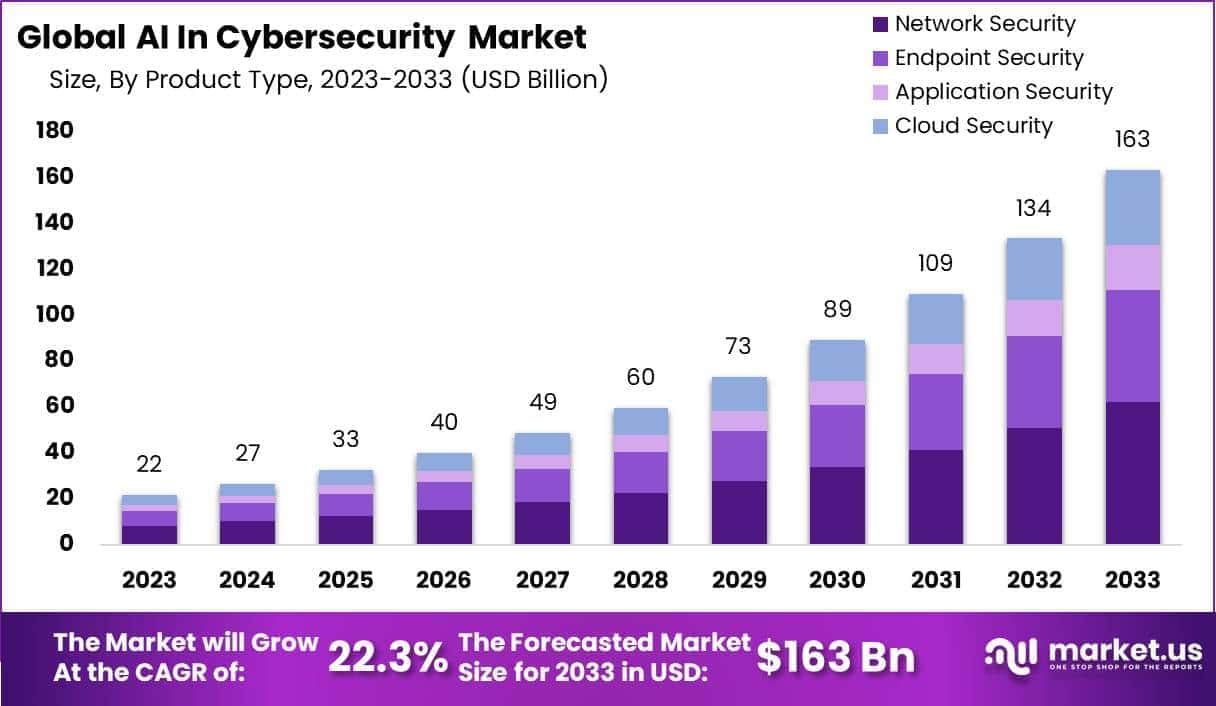
- According to Security Intelligence, the average total cost of a data breach in 2022 increased to about USD 4.35 million, marking a 2.6% rise from the previous year’s USD 4.24 million. This increase reflects the growing financial risk caused by cyberattacks.
- As reported by the World Economic Forum’s Global Cybersecurity Outlook 2023, nearly 84% of organizations are now using AI tools to strengthen their security systems and reduce cyber risks.
- The European Union Agency for Cybersecurity (ENISA) reported a 30% increase in the adoption of AI-based security technologies over the past year, showing companies’ growing focus on protecting sensitive data.
- The Services segment held the largest share in 2023, accounting for more than 35% of the total AI in cybersecurity market.
- The Network Security segment dominated the market in 2023, holding over 38% share due to the growing need for network protection solutions.
- The Machine Learning (ML) segment captured more than 47% of the market in 2023, reflecting its critical role in detecting and preventing security threats.
- Fraud Detection and Anti-Fraud solutions accounted for more than 20% share in 2023, as businesses increasingly relied on AI to monitor financial transactions.
- The BFSI (Banking, Financial Services, and Insurance) sector led the market with over 28% share in 2023, as financial institutions adopted AI for fraud prevention and compliance.
- North America dominated the global market with more than 36% share in 2023, supported by strong investments in AI-based cybersecurity technologies.
- Around 55% of companies worldwide plan to use AI for improving cybersecurity in 2024, showing a sharp rise in AI integration.
- Approximately 21% of IT decision-makers believe AI can help develop more effective security policies and rules.
- Nearly 19% of respondents expect AI to be most useful for attack simulation and compliance monitoring in 2024.
- About 63% of security professionals believe AI will enhance security operations, particularly in detecting and responding to threats faster.
- Only 12% of professionals think AI will completely replace their roles, indicating that AI is seen as a support tool rather than a replacement.
- Around 30% of experts expect AI to improve their technical skills, while 28% believe it will provide general assistance in their work.
- Nearly 24% of security professionals think AI will take over major parts of their routine tasks, allowing them to focus on more complex responsibilities.
- C-suite executives reported a higher 52% familiarity with AI technologies, compared to only 11% among staff members, highlighting a gap in AI knowledge within organizations.
- More than 55% of organizations plan to implement generative AI tools in 2024, marking a key shift toward advanced AI adoption in the cybersecurity industry.
AI In Cybersecurity By Regional
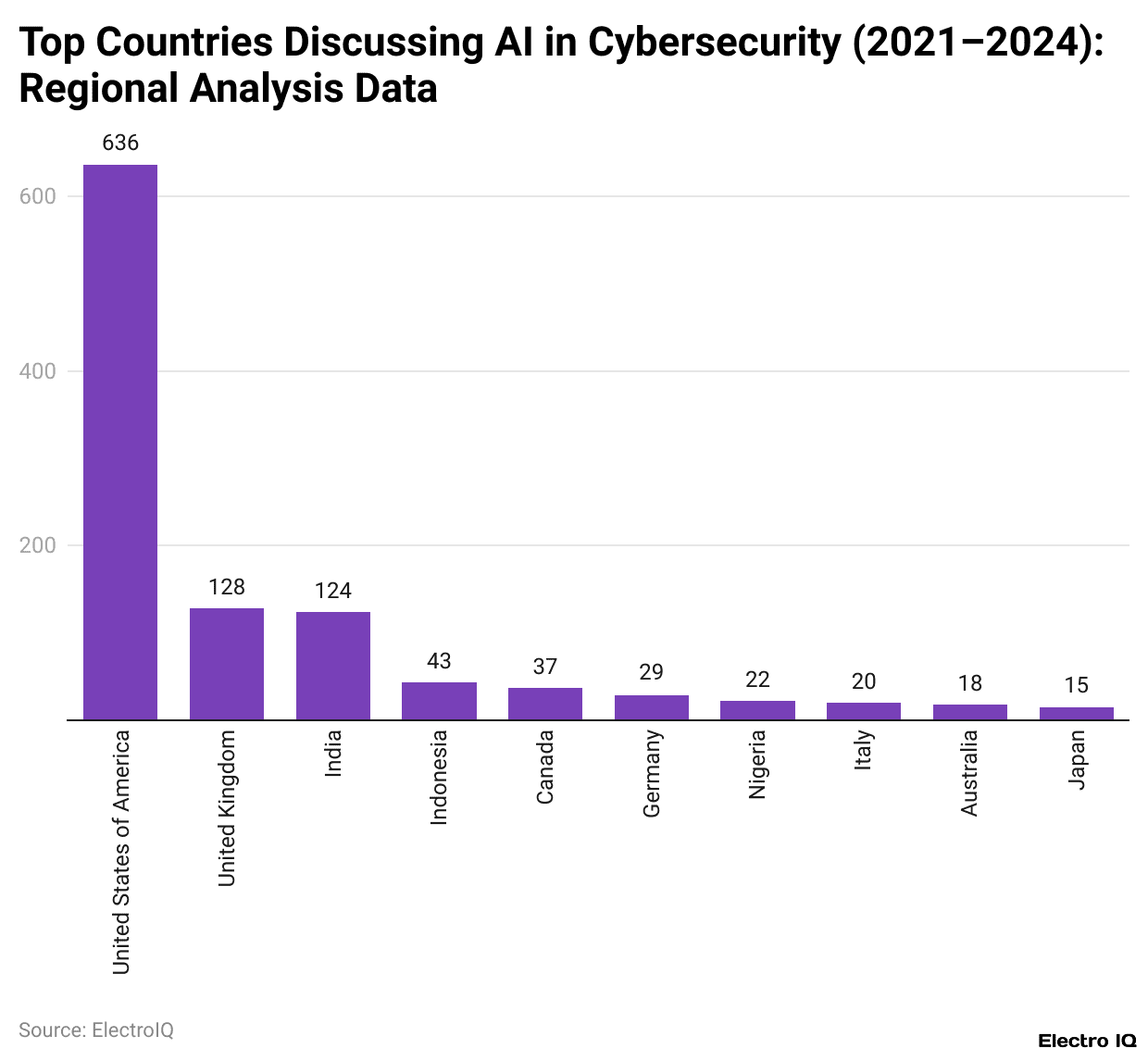
(Reference: allaboutai.com)
- The latest bar graph depicts the ten nations that were the most active in discussions about artificial intelligence in the area of cybersecurity from the year 2021 to 2024.
- The US is the undisputed champion with a massive margin, 636 mentions, which proves that it is the most influential nation in the field of AI and cybersecurity discussions worldwide.
- This is an indicator of the country’s considerable technological leadership and its ongoing commitment to digital defense innovation through financing.
- The UK is the runner-up with 128 mentions, which is proof of its slowdown yet persistent participation backed by the sector of AI innovation, which is expanding rapidly.
- Right at its heels, India tallies 124 mentions, which indicates its rising ambition to integrate AI into cybersecurity strategies as it positions itself among the major global tech hubs.
- From Southeast Asia, Indonesia provides 43 mentions, which denotes the increasing consciousness of AI’s ability to reinforce the country’s cybersecurity infrastructure.
- Canada, with 37 mentions, is a place where moderate yet consistent engagement is observed, mainly because of the thriving research community and the ecosystem of AI-driven startups that is flourishing.
- And at the same time, Germany has 29 mentions, which is the very number that proves Europe’s dominance in AI for cybersecurity, courtesy of the country’s emphasis on industrial tech and innovation.
- Countries with less developed economies in the world are also coming to the fore.
- For instance, Nigeria, with 22 mentions, is a clear example of how Africa is becoming increasingly interested in adopting AI to tackle cybersecurity issues.
- In a similar way, Italy increases its number of mentions by 20, which is indicative of the country’s growing interest in the use of AI technologies for national security.
- Australia, on the other hand, mentions AI in connection with both national defense and cyber resilience, and its total number of mentions is 18, which is also an indicator of growing interest in AI applications for those purposes.
- Japan, 15 mentions, is the last to be mentioned in this context, as it is the country that is “surfing the AI applications experimentation, particularly in the field where cybersecurity meets with robotics and automation.
Cost And Frequency of AI Cybersecurity
- According to Darktrace, the most serious AI-based security threats include malware attacks, exploitation of software weaknesses, exposure of sensitive data through generative AI, social engineering, and undiscovered zero-day vulnerabilities.
- About 74% of IT security professionals said their organizations have been strongly affected by AI-driven cyber threats.
- Data from Deep Instinct shows that 75% of cybersecurity professionals had to adjust their protection strategies during the past year to manage AI-related attacks.
- Around 97% of experts believe their organizations are likely to experience AI-generated security breaches in the future.
- Netacea found that 93% of companies expect daily AI-powered attacks within the next year.
- Approximately 87% of IT professionals think these AI-related risks will continue to affect their organizations for many years ahead.
- IBM reported that the global average cost of a data breach has reached $4.88 million, showing a 10% increase compared to the previous year and marking a record high.
- Findings from the Ponemon Institute reveal that 56% of companies commonly face phishing and social engineering attacks, 50% report web-based intrusions, and 49% experience credential theft incidents.
AI-Driven Cybersecurity Prevention Aids
- The latest research indicates that the majority of businesses are still taking time to discover the effective use of AI in the cybersecurity sphere, but the ones that do are already reaping the benefits.
- Darktrace claims that only 15% of security stakeholders trust the capabilities of traditional non-AI tools in detecting or defending against the threats posed by AI.
- According to a study by the Ponemon Institute, the number of organizations that see the potential of AI in their security systems is 44%, and 62% can pinpoint specific areas where machine learning can boost their security.
- Quite a number of teams have found AI to be beneficial in various practical ways, with the majority of cybersecurity professionals (around 67%) stating that they mainly use AI to develop detection rules based on known attack vectors and indicators.
- The use of AI in uncovering the crucial talent shortage in cybersecurity is another area where it is being most helpful.
- Moreover, 70% of experts assert that with AI, identifying a threat that older tools would miss is a matter of the past, as AI has been very effective in this regard.
- Deep Instinct data indicate that about 73% of cybersecurity teams want to engage more in the use of AI for the prevention of attacks before they happen. Nevertheless, the journey has not been the same for all companies.
- Approximately 53% of the respondents stated that they are still in the nascent phase of AI tool adoption, while 65% are confronted with problems merging these modern systems with traditional legacy technologies.
- Merely 18% of the security departments have completely brought in AI cybersecurity measures throughout their businesses.
- Owing to these challenges, the path is very clear – businesses consider AI to be a strong partner in the fight against intricate cyber threats, and its participation in the area of prevention and detection is likely to escalate very soon.
AI Phishing Statistics
- According to VIPRE Security Group, 40% of phishing emails sent to businesses are now created using artificial intelligence tools.
- As reported by Harvard Business Review, 60% of people who receive AI-generated phishing emails end up falling for them, which is nearly the same rate as traditional phishing emails.
- The same source states that cybercriminals can cut their campaign costs by about 95% by using large language models to write phishing emails.
- IBM reported that phishing-related data breaches cause an average financial loss of $4.88 million per incident.
AI Deepfakes Statistics
- According to Deep Instinct, about 61% of organizations experienced more deepfake attacks in the past year, showing how rapidly this threat is spreading.
- VPNRanks reported that deepfake incidents are expected to rise by 50% to 60% in 2024, reaching between 140,000 and 150,000 cases worldwide.
- Deep Instinct also found that around 75% of these attacks were designed to impersonate top executives such as CEOs or other senior leaders.
- Deloitte estimated that financial losses from deepfakes and similar AI-driven crimes could rise by 32%, reaching $40 billion each year by 2027.
- Data from the Federal Bureau of Investigation indicated that impersonation scams led to $12.5 billion in losses across the United States in 2023.
AI Ransomware Statistics
- According to Netacea, about 48% of security professionals believe that future ransomware attacks will be powered by artificial intelligence.
- As stated by IBM, the average cost of a ransomware attack to a company is approximately USD 4,450,000.
- Based on Fortinet’s findings, ransomware incidents increased by 13 times in the first half of 2023 compared with their previous share among all malware detections.
AI Cryptocrimes Statistics
- According to Bitget, deepfakes are projected to make up 70% of all cryptocrimes by 2026, reflecting the growing misuse of artificial intelligence in financial deception.
- As reported by the Federal Bureau of Investigation, total cryptocrime losses in the United States reached 5.6 billion dollars in 2023, representing 50% of all reported financial fraud losses nationwide.
- The same source revealed that cryptocurrency-related losses increased by 53% between 2022 and 2023, showing a sharp rise in digital asset fraud incidents within a single year.
Key Players
Among the technology companies that have invested heavily in AI for cybersecurity, some of them are also the ones showing different financial trends in the last few years.
NVIDIA Corporation
- NVIDIA Corporation posted remarkable results for the third quarter of the 2024 fiscal year.
- The total revenue of US$18.12 billion was attained, which is a 20% rise from the previous year, and also a 34% increase over the last quarter.
- The GAAP per share earnings reached US$3.71, which is a notable increase from US$0.27 in the same quarter of last year, and this is all due to the high demand for NVIDIA’s AI and computing products.
Intel Corporation
- Intel Corporation had a downfall in terms of sales. Intel reported US$52.86 billion for the twelve months ending on September 30, 2023, which is a year-over-year decrease of 23.98%.
- In 2022, Intel’s annual revenue was US$63.05 billion, which is a drop of 20.21% when compared to 2021, during which the company earned US$79.02 billion – a slight increase of 1.49% over 2020.
Xilinx Inc
- Xilinx Inc., a significant contributor to adaptive computing, reported an all-time high revenue of US$1.01 billion for the third quarter of fiscal 2013, which is an 8% increase from the previous quarter.
- The net income of the company, according to GAAP for that period, was US$300 million, which translated to US$1.19 per diluted share, thus proving the company to be quite a profitable one during that time.
Samsung Electronics
- Samsung Electronics Co. Ltd. had a great time in India, where its revenue for 2022–2023 amounted to ₹998,924 crore, reflecting a 16% growth as compared to the previous fiscal year.
- The operating profit of the company, however, was down 10% at ₹3,452 crore, indicating that the sales might have increased, but the profit margins got squeezed.
Micron Technology Inc
- The downfall of Micron Technology Inc. was very abrupt in 2023 when the company reported its annual revenue of US$15.54 billion, down by 49.48% as compared to 2022.
- In the previous year, Micron reported a revenue figure of US$30.76 billion, which was an 11.02% increase from 2021 when the company had a revenue of US$27.70 billion —this was an impressive 29.25% rise from 2020.
- This swing in fortune is a clear signal of the volatility in the semiconductor and memory markets, which are significantly influenced by the cycles of demand.
IBM Corporation
- IBM Corporation was also able to show persistent growth of profits.
- The company’s gross profit for the year ending September 30, 2023, was US$33.67 billion, indicating a year-on-year growth of 3.42%.
- The unwavering performance of IBM signifies that the company continues to be a major player in the field of enterprise computing and AI-based cybersecurity solutions.
Top Platforms Driving AI In Cybersecurity
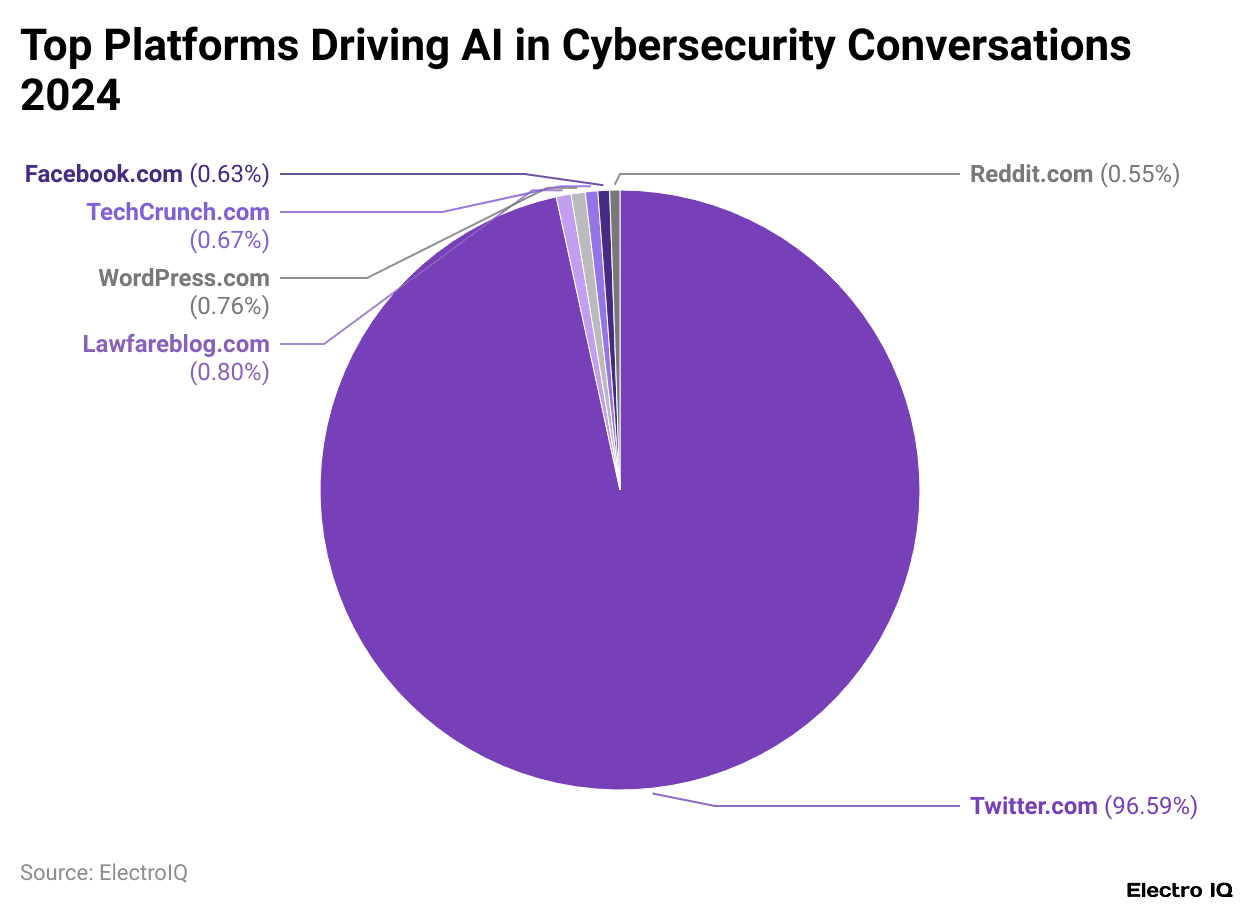
(Reference: allaboutai.com)
- According to research, global conversations about AI in cybersecurity are mainly fueled by Twitter and other online platforms.
- Twitter is the major contributor with a considerable margin, representing 87% of the total mentions (2,302), thus being the primary source for real-time updates and public participation.
- Lawfareblog ranks second with 19 mentions, which draws in policymakers and legal professionals, while WordPress and TechCrunch have 18 and 16 mentions, respectively, providing analysts with detailed insights and tech-focused analyses.
- Facebook (15 mentions) and Reddit (13 mentions) support discussions that are more community-oriented. Besides, YouTube, Substack, and Yahoo are some of the other platforms that contribute to the conversation.
- The results imply that the role of each platform is different—from fast-paced information sharing on Twitter to expert commentary and the negotiation of ideas on more niche or community platforms.
Planned Investments in AI-driven Cybersecurity
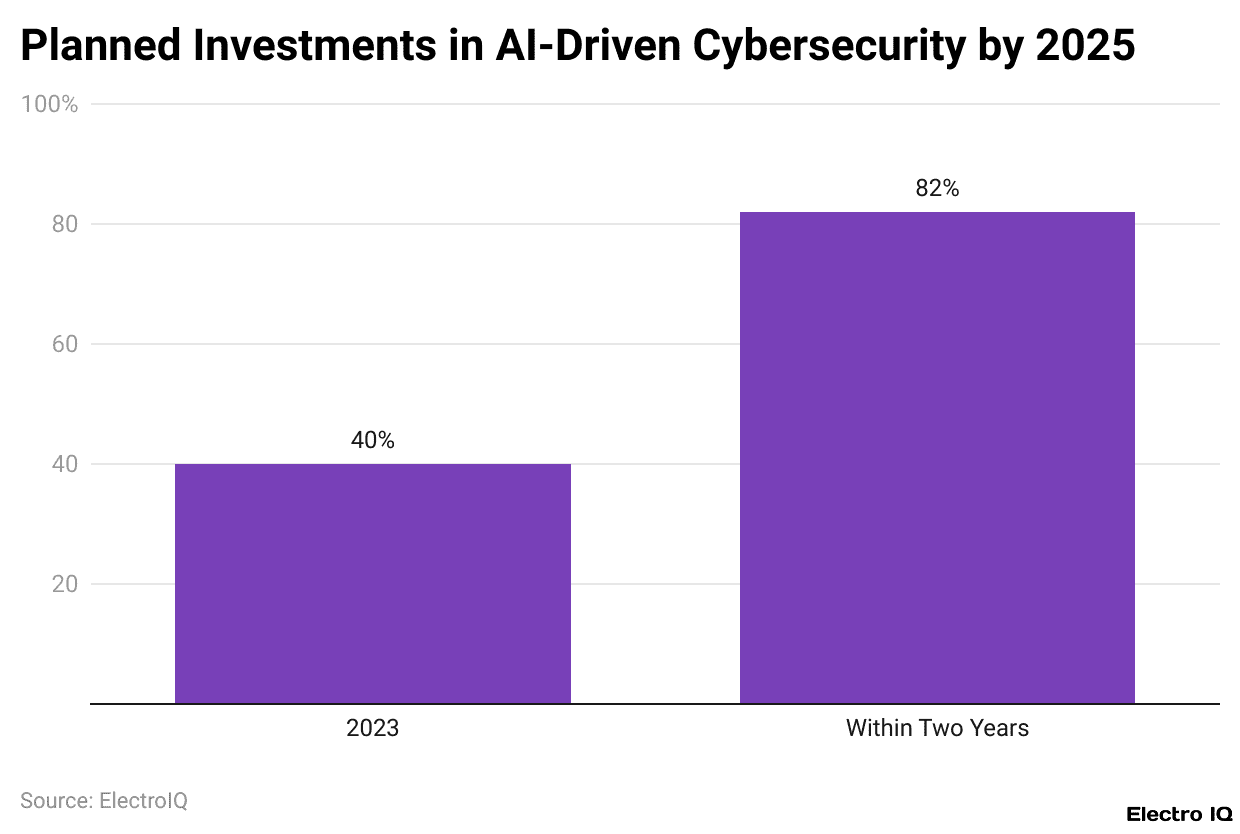
(Reference: allaboutai.com)
- Investments in AI-driven cybersecurity tools were planned by about 48% of IT leaders in 2023 and this is the number that will increase to 82% in the next two years, which is the case for almost half of them.
- This increasing investment shows that the advanced AI technology has become very important for the fight against constantly evolving cyber criminals.
- The companies are well aware that the conventional security measures are not good enough anymore, whereas AI provides faster detection, better prediction, and more proactive protection.
Technology Adoption
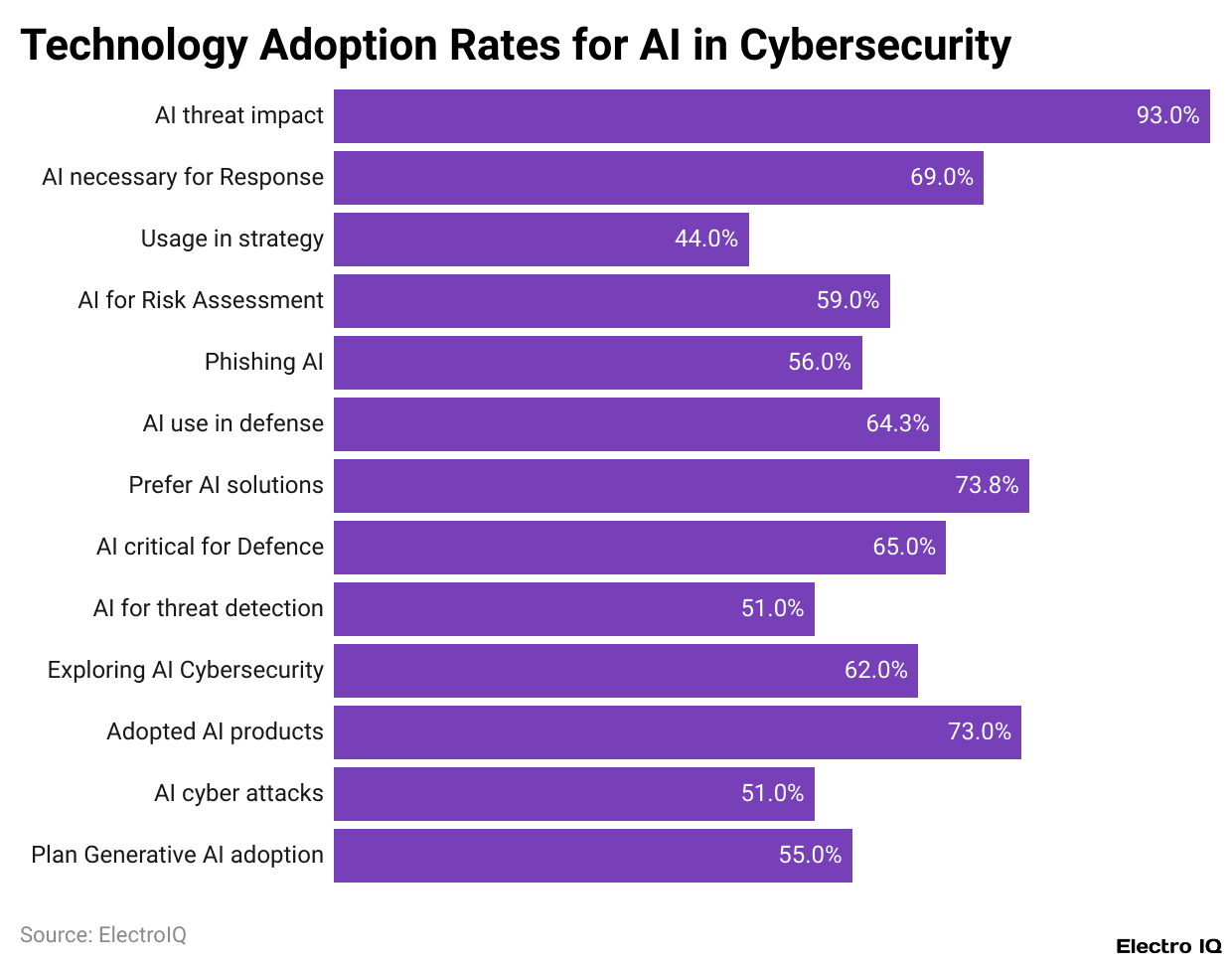
(Reference: allaboutai.com)
- In the world of cybersecurity, professionals are becoming more and more aware of AI-enabled threats, with 93% believing that such attacks are going to affect their companies.
- These attacks are often carried out using advanced algorithms that imitate human behavior or could even trick security systems, thereby making them hard to detect through traditional ways of security.
- Moreover, as attacks tend to become more intricate or sophisticated, 69% of the professionals think that the role of AI would be vital in managing the situation in an effective manner, as its performance strengths of quick processing of large chunks of data, uncovering patterns, and predicting possible attacks will be utilized.
- Approximately 44% of firms have incorporated AI tools into their security plans, indicative of a movement towards the deployment of more automated and intelligent defenses.
- Besides, 59% of organizations are using AI for evaluating and ranking the risks on their networks, thus enabling them to pick the weaknesses that need to be tackled first and to distribute the assets in a more efficient manner.
- Phishing still is the primary threat, and 56% of the IT officers point to targeted phishing attacks as the main risk, which in turn emphasizes the indispensable role of AI in both detection and prevention.
- In the United States, 64.3% of organizations have integrated AI into their cybersecurity efforts, and 73.8% prefer AI-powered solutions for continuous 24/7 monitoring and incident response.
- Similarly, 65% of professionals view AI as vital to their defense strategies, while 51% of executives actively use AI to detect threats, showing strong support from leadership.
- The trend continues globally, with 62% of enterprises either adopting or exploring AI for cybersecurity, and 73% using AI-integrated security products.
- However, AI’s dual-use nature is a concern, as 51% of IT professionals reported that some successful cyberattacks in 2024 were AI-powered.
- Looking ahead, 55% of organizations plan to adopt Generative AI solutions this year, signaling confidence in advanced AI technologies to transform cybersecurity defenses, generate new data patterns, and address evolving threats more effectively.
AI Role In Enhancing Cybersecurity Efficiency
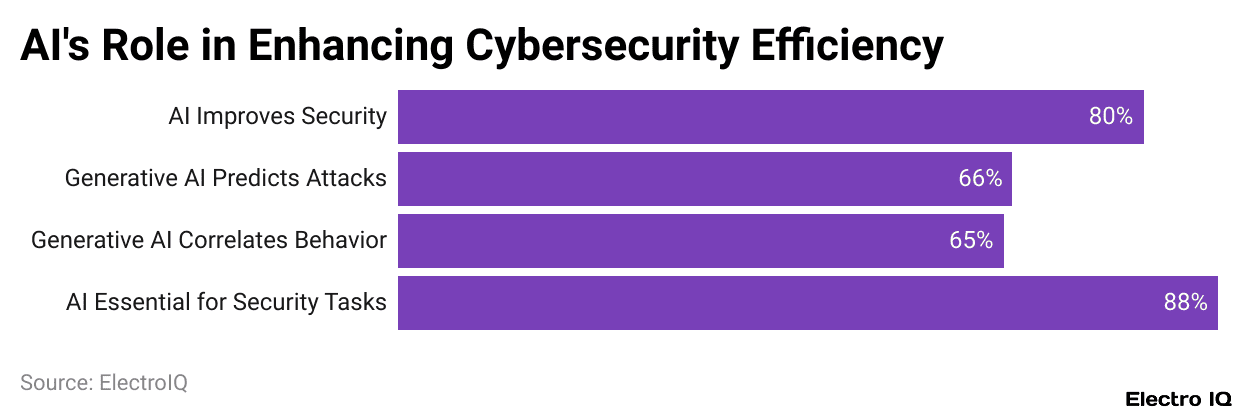
(Reference: allaboutai.com)
- A significant majority of cybersecurity professionals recognize the advantages of AI in enhancing security.
- Around 80% believe AI improves detection by spotting threats that humans might miss.
- Approximately 66% of the organizations that have adopted AI technology support the prevention of zero-day attacks, which are those attacks that exploit previously unknown vulnerabilities.
- Generative AI, by conducting in real-time the simulation of numerous attack scenarios that ride on data trends, provides the cybersecurity teams with tomb of foresight in their efficiency for strengthening defense.
- Further, 65% of the total witnesses agree that it aids the correlation of user behavior, which helps in the detection of unusual activities, thus allowing the identification of threats to be more subtle and contextually aware.
- 88% of people in the profession think that without the help of AI, it would be impossible to carry out security tasks efficiently. This is a clear indication of increased reliance on AI to manage difficult workloads, improve accuracy, and cope with the ever-increasing volume and complexity of cyber threats.
Cybersecurity With AI-Driven Threat Detection And Response
- The use of AI technologies in cybersecurity is revolutionizing the way companies detect and respond to cyber threats, thus, the faster and more accurate identification of complex attacks that traditional methods might miss is enabled.
- The banking industry has seen a rise in cyber-attacks by 280%, which emphasizes the increasing difficulty that financial institutions have to deal with.
- The situation is such that the scale or sophistication of many of these attacks is within the capacity of AI tools.
- AI, in synergy with human effort, offers both preventive and reactive solutions to mitigate the impact of these threats by effectively analyzing patterns, detecting anomalies, and implementing real-time security measures.
- It is predicted that, by the year 2024, 75% of the systems for automated threat intelligence and prevention will be able to actively deal with cyber threats.
- According to a report from the cybersecurity field, there has been a significant increase in machine-based attacks, which already amounts to more than 51%.
- AI plays a critical role in the defense against these attacks because it can match the speed and the level of complexity, which points out the ongoing battle between the sophisticated cybercriminal strategies and the AI-based security systems.
Challenges of AI In Cybersecurity
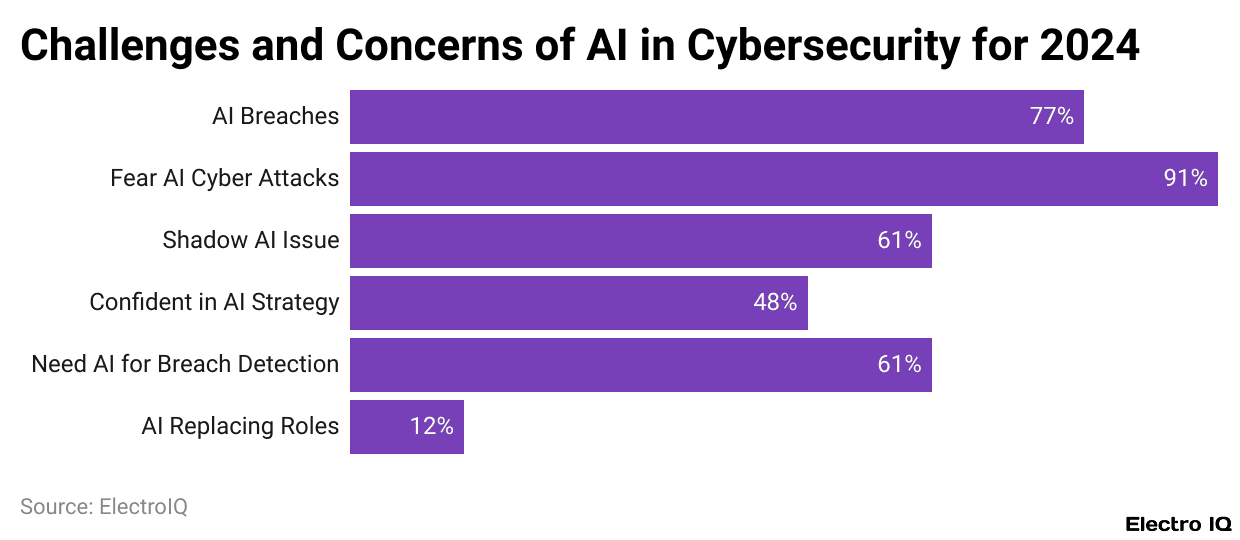
(Reference: allaboutai.com)
- A large number of corporations are struggling with the protection of their AI systems, and 77% of them have been breached during the last year.
- Approximately 91% of the professionals are of the opinion that there is a chance of AI being used as a weapon in cyberattacks.
- On the other hand, there are already some AI models that are used by the shady side of the internet, like WormGPT, FraudGPT, and DarkBERT, and these models are helping criminals with the automation of phishing, malware generation, and bypassing traditional detection methods.
- Shadow AI, which is the employment of AI applications without formal organizational approval, is one more apprehension that is gaining ground, with 61% of IT leaders recognizing it as a difficulty.
- Only 48% of the professionals consider themselves ready to use AI resourcefully.
- More than 61% confess they would have a hard time trying to spot hacking attempts if AI were not there, which throws the spotlight on technology’s essential place in dealing with sophisticated and heavy cybersecurity tasks.
- The concern over AI taking over human jobs is not so assertive; merely, 12% of the security practitioners are worried about being completely replaced by AI. This implies that, although AI is altering the way cybersecurity is done, the majority of professionals see it as an aid to human efficiency rather than a substitute.
Cybersecurity Concerns Related To AI
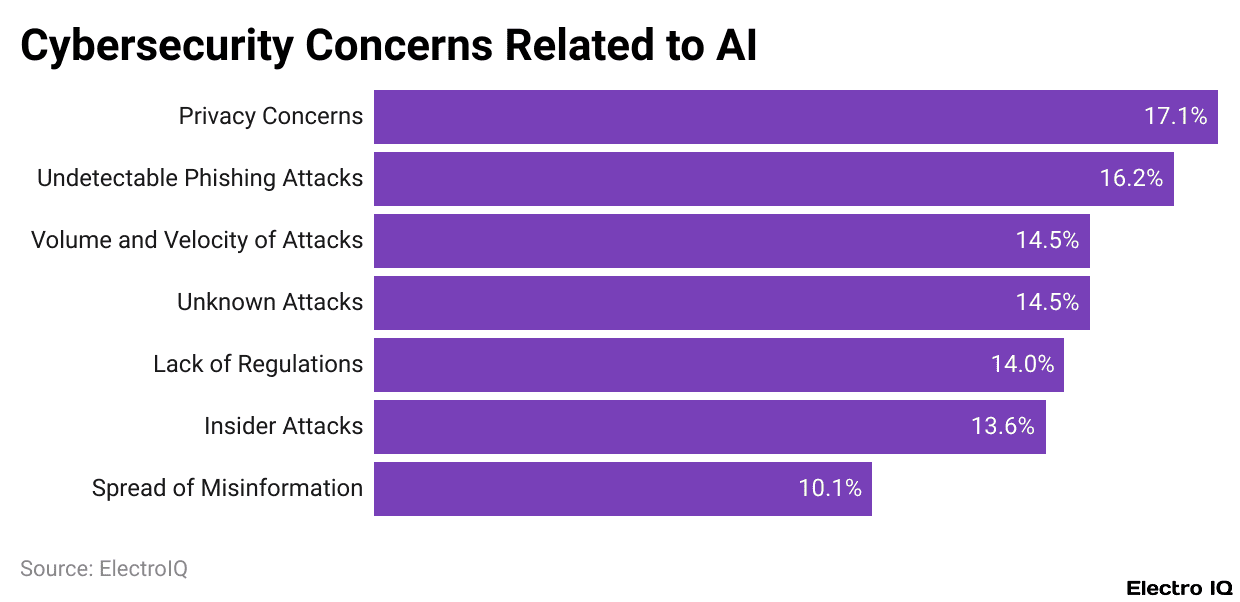
(Reference: allaboutai.com)
- Cybersecurity specialists are more and more worried about the dangers linked to AI deployment.
- The main concern, mentioned by 39% of the experts, is that AI might result in a more difficult-to-handle privacy scenario, which indicates the apprehension about the control, sharing, or exposure of personal data.
- Very near to this, 37% of the professionals are concerned that AI might be an enabler of more advanced phishing attacks that are less likely to be detected, as AI can create very likely fake messages or personas.
- In total, one-third of the participants pointed out both the attack volume and speed as a major concern, as well as the increasing issue of deepfakes.
- In the same breath, 33% of the respondents indicated that among their worries is the existence of unknown attacks that could catch even the most advanced security tools unawares, thus stressing the point of the sole threat of new attackers outstripping the current defense systems.
- Another matter of great concern is the generative AI being unregulated, which was expressed by 32% of the experts, and indicates the risk of abuse in the absence of control.
- Insider threats that involve using AI to perpetrate attacks are a source of anxiety for 31% of the respondents, who see the technology as a means to either automate harmful acts or cover up maliciousness.
- Also, 23% of the respondents indicate the use of AI in the better dissemination of fake news that could ultimately alter the opinion of the public and even decide what the truth is.
AI Improvements In Cybersecurity
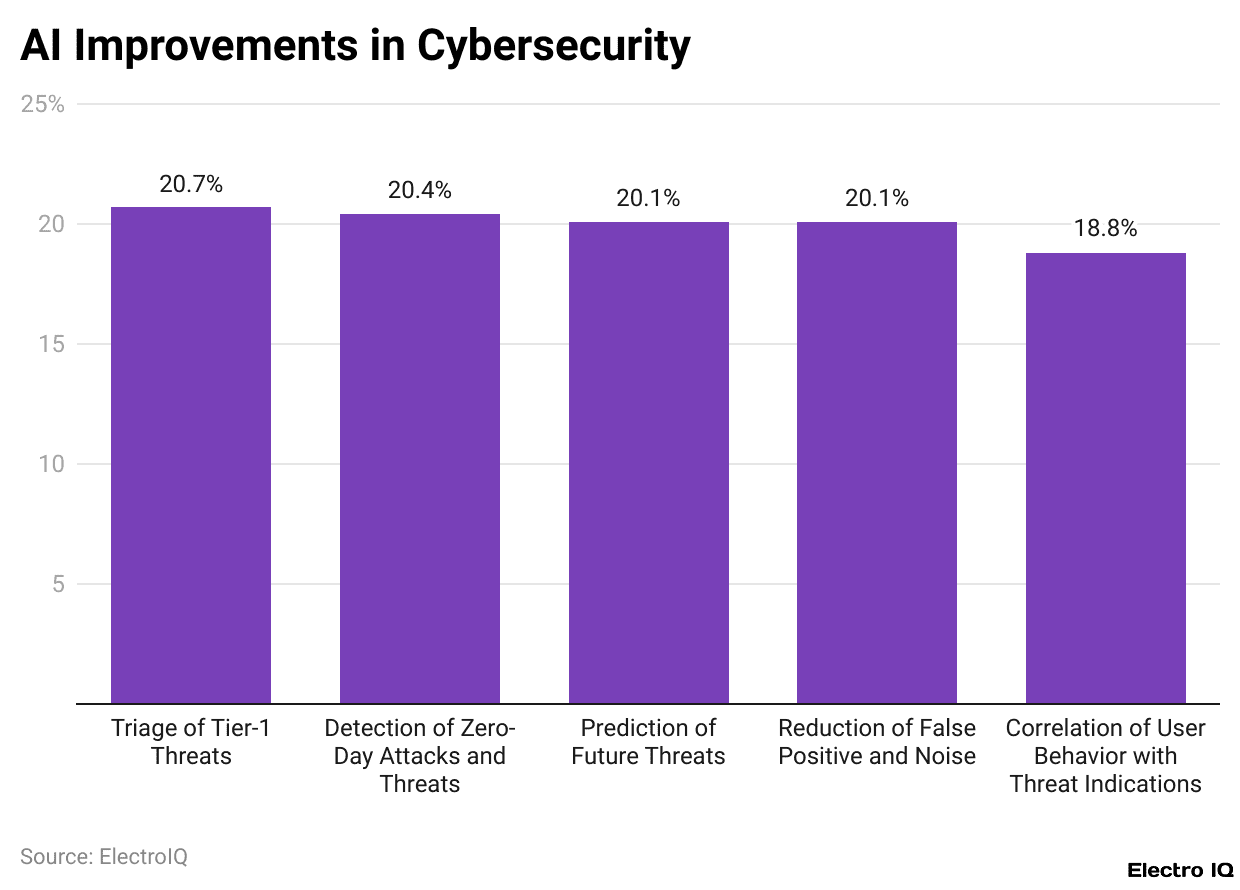
(Reference: allaboutai.com)
- The companies that have brought AI into their cybersecurity measures are reportedly enjoying an overwhelming performance improvement across different sections of the business.
- The enhancement in the triage of Tier 1 threats is one of the most considerable changes, with 67% of the companies saying that AI not only helps them but also allows them to manage and give priority to lower-severity, high-volume threats much more effectively.
- In the same way, two-thirds (66%) of the companies surveyed believed that AI was a very important tool to help them find zero-day attacks, which are new and unknown weaknesses at the same time that they are not yet protected or guarded against by patches or any other means.
- Its trend and pattern analysis has won 65% of the users’ votes as a risk forecasting method. This ability to tell the future is necessary for protective measures that are taking place before the attack actually occurs.
- Another 65% credited AI with the ability to drastically reduce false positives and background noise, thus allowing the analyst to concentrate on real threats while the time wasted on wrong alerts is cut down.
- Also, 61% of the enterprises make use of AI to link the user activity to the threat indicators, which results in being able to detect the potential of the user being suspicious more correctly.
- Although this particular application of AI is the least mentioned, it is still very important in figuring out the behavioral patterns that may give rise to insider threats or even compromised accounts.
AI In Cybersecurity Across Industries
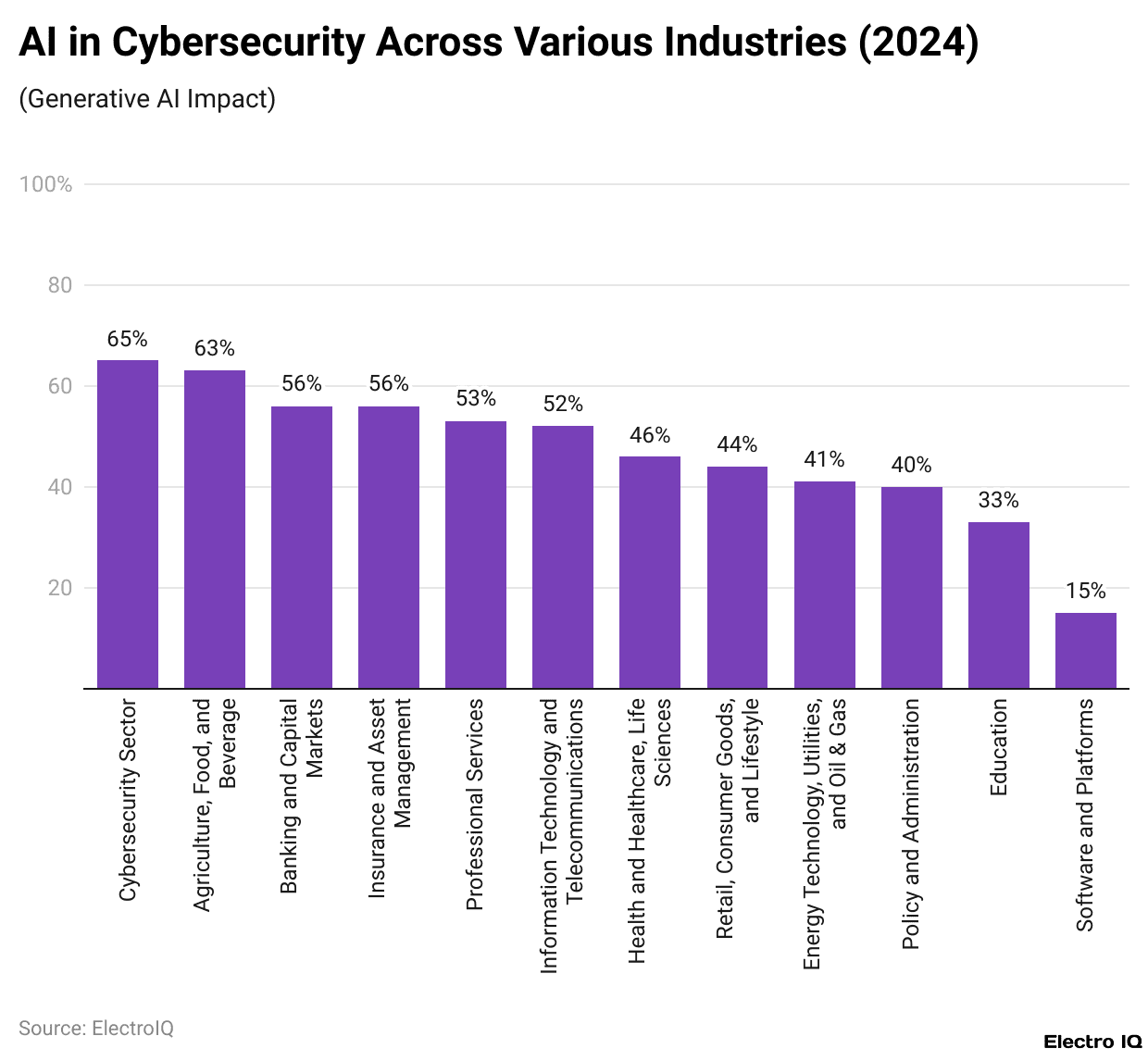
(Reference: allaboutai.com)
- In the report released by the World Economic Forum, titled the Global Cybersecurity Outlook 2024, it is stated that AI is making great strides in the area of cybersecurity and has already started to reposition its capabilities according to the needs of the different sectors.
- The leaders of two-thirds (65%) of the cybersecurity sector think that generative AI will be the one controlling most of the activities in the sector, while an impressive 94% are very sure that their organizations will continue to be resilient against cyber-attacks.
- One of the sectors that follows this trend is agriculture, food, and beverages, with 63% of the leaders forecasting that AI will have a very strong influence over the sector, while only 38% believe that they can somehow withstand the impact of cyber threats.
- The same percentage of 56% coming from the banking and capital markets world expects AI to draw major lines for these sectors, yet only 68% claim to have even slight toughness against cyberattacks.
- The insurance and asset management divisions are also at the same level, where 56% of the people predict an AI-driven future; however, one of the sectors shows much stronger preparedness, with 89% judging themselves as cyber resilient.
- Professional services expect 53% AI influence and give 69% confidence in their resilience. The IT and telecommunications sector also shows strong confidence.
- With 52% expecting major AI influence and 81% considering themselves resilient.
- In health and life sciences, 46% forecast significant AI changes, but only 62% claim minimal resilience.
- Retail, consumer goods, and lifestyle show the same pattern, with 44% forecasting AI’s strong influence and 67% having basic resilience.
- Among other things, the healthcare and life sciences industry perceives a 46% radical AI-induced alteration, yet merely 62% claim they have minimal resiliency.
- The retailer, consumer products, and lifestyle businesses picture the same future, with 44% choosing AI’s strong impact and 67% together with basic resilience.
- The oil, gas, energy, and utilities are quite positive, with 41% indicating AI change in their sector and 94% very sure of their resilience.
- Government and administrative services have 40% anticipating AI’s influence and 60% being resilient.
- In educational institutions, 33% predict AI will have a greater impact, and 67% feel secure, while the software and platform businesses exhibit 15% of the majority expecting considerable impact, but 77% backing resilience.
The Growing Role of AI In Shaping The Future of Cybersecurity
- Artificial intelligence (AI) is now a very important factor in the cybersecurity world, where attacks are becoming more frequent and complicated. It introduces both opportunities and hurdles to the already uncertain digital sphere.
- On the one hand, there are discussions going on about the dangers that AI entails, while on the other hand, it also gives creative methods to combat cyber threats, which is why it has become a vital weapon in the current cybersecurity methods.
- The worldwide market of AI in cybersecurity is one of rapid expansion, and it is anticipated that its value will increase from US$30 billion in 2024 to about US$134 billion by 2030, which denotes strong long-term investment and trust in AI protection technologies.
- By the year 2024, more than 66% of IT and security professionals across the globe had done some AI testing for security, and an additional 27% were soon going to try it out.
- Among the chief applications of AI in the field of cybersecurity are network traffic monitoring, the creation of defense simulations, and the prediction of future cyberattacks.
- Nonetheless, the AI technology is also a cause of worry concerning new security issues. Cybercriminals are taking advantage of AI, particularly generative AI, to enhance their illegal activities like phishing, virus writing, and making deepfakes.
- Generative AI, which is a branch of machine learning, applies deep learning techniques to produce text, pictures, or computer code that match user instructions.
- This has been the technology that has been getting a lot of attention through the likes of ChatGPT from OpenAI, and it has been gradually moving to other business sectors like cybersecurity.
- Generative AI has the potential to sift through huge amounts of data to spot anomalous or questionable behavior much quicker and with greater precision than humans, thus enabling organizations to timely and economical manner.
- Generative AI enjoys the duality of being a mighty weapon for both defense and offense.
- It makes the former create more and more realistic scams, fake identities, and automated attacks, which lead to an increase in the scale and sophistication of cyber threats.
- Going ahead, companies will have to be at the forefront of the changes by adopting new technologies, inventive practices, and continuous upgrading of their cybersecurity models so that the generative AI becomes a powerful ally instead of a weak point for the attackers.
- The struggle between the different sides of compliance and sufficiency in terms of technological advancements will create the future of AI in cybersecurity: as an asset or liability.
Conclusion
AI in Cybersecurity Statistics: The impact of artificial intelligence on security has been enormous and rather sudden; thus, nowadays, companies investing in AI-based technologies, at the very least, gain both powerfully equipped and vulnerable to exploitation. No matter the nature of threats, AI, in which supported tools are now indispensable for faster detection, predictive threat analysis, and automated response.
However, the same technologies are being exploited by the attackers, thereby amplifying the risks associated with deepfakes, phishing, and even AI-generated malware. The forecast of the global market hitting US$134 billion in 2030 only highlights AI’s significant role in digital defense. As we move towards the future, the winning strategy will entail a blend of innovation, regulation, and ethical use, making sure that AI acts as an ally in cybersecurity rather than being a culprit in the creation of new threats.
FAQ.
AI is bringing about a complete overhaul of the security sector by not only enhancing detection of threats but also automating the process of response to such incidents and marketing predictive strategies that can foresee the occurrence of new attacks.
The market for AI in cybersecurity is experiencing a significant upward trend, with an estimated value of about US$30 billion in 2024, ascending to US$134 billion by 2030.
AI brings along the detection of zero-day attacks at a much quicker pace, diminished false positives together with better prediction of threats. Besides it closes the skills gap by taking care of the menial tasks that are usually boring for the human analysts and letting them the strategic planning. On the average, 80% of the professionals are of the opinion that AI has enhanced the accuracy of detection while 88% consider it indispensable for the smooth operation of cybersecurity.
The users of AI in cybersecurity are mainly the experts who are afraid of the privacy issues, phishing through AI, deepfakes, and the attacks which remain undetected by the existing tools. A survey conducted reveals that 91% of the professionals are of the opinion that AI could be harnessed as a tool for cyber warfare through the use of malign applications like WormGPT and FraudGPT.
AI is having a positive impact on almost all industries including finance, healthcare, energy, and education. The cybersecurity market is leading in its adoption with 65% of the leaders foreseeing substantial AI-induced changes in a couple of years. The banking, insurance, and IT sectors are quickly incorporating AI for detecting threats, while healthcare and education are still on their way to being resilient.

I hold an MBA in Finance and Marketing, bringing a unique blend of business acumen and creative communication skills. With experience as a content in crafting statistical and research-backed content across multiple domains, including education, technology, product reviews, and company website analytics, I specialize in producing engaging, informative, and SEO-optimized content tailored to diverse audiences. My work bridges technical accuracy with compelling storytelling, helping brands educate, inform, and connect with their target markets.

